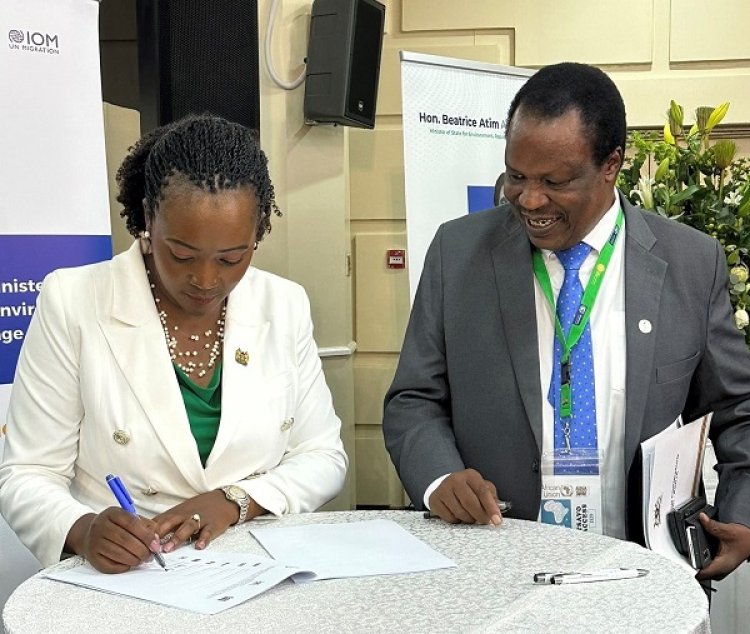Sylvie Nzungu, a 49-year-old mother and grandmother, had called Kigali’s lively Gatsata neighborhood home for three decades. She has held two weddings, one funeral and holds many other life memories in her house. Her family partly relied on the income from rented houses in the compound to survive.
Nzungu and her two daughters also run a tailoring shop in Kigali’s business district, their main source of income. A few weeks ago, Nzungu’s family was fairly stable until their lives changed.
Their home, Gatsata, is prone to landslides and floods during recurrent adverse rains disasters that the country has had to grapple with for decades, especially since 2015 when such events intensified to levels never seen in about 40 years according to the weatherman.
Whenever these climate change-induced adverse rains strike, they leave behind trails of loss of lives, property, infrastructure, and displacements.
To adapt, the Rwandan government decided that people in localities like Nzungu’s must leave. The families here had little choice but to move to other neighborhoods within Kigali or far, and many homeowners end up in a situation of renting.
Nzungu, her three children, and two grandchildren rely solely on their tailoring shop, though living costs in a safer neighborhood are higher. Their quality of life has declined, and financial hardships have intensified.
Also read: Will historical emitters heed Africa call for debt-for-climate swaps?
Scrutiny
Authorities have come under scrutiny over the demolitions because they leave families like Nzungu’s in the lurch, struggling to cope with the sudden displacement and the financial burden of adapting to a safer but more expensive neighborhoods.
In recent weeks, up to 800 households were evacuated from Gisozi, one of Kigali’s most densely populated neighborhoods. Hundreds more have been removed from other high-risk zones in Kimihurura, Kimicanga, Gatsata, and Nyamirambo, all within Kigali.
Authorities have come under scrutiny over the demolitions because they leave families in the lurch, struggling to cope with the sudden displacement and the financial burden of adapting to a safer but more expensive neighborhoods.
This, yet again, highlights how the very families who are least responsible for the global climate crisis are bearing the cost of these necessary adaptations, a harsh reminder of the complex social and economic challenges intertwined with the fight against climate change faced by many developing countries.
Also read: Rwanda floods: The not-so-visible hand of wealthy nations
Previous floods have beset, for instance, Rubavu, a district grappling with a series of calamities, from the 2021 Nyiragongo volcanic eruption, the Covid-19 pandemic induced disruption of tourism, Rwanda-DRC security tensions, to the devastating May 3rd floods and landslides – dealing yet another blow. Displaced families, akin to Nzungu’s ordeal, remain unsettled, and small businesses battle to recover.

Adaptation
Rwanda’s struggle with climate change is a long-standing ordeal, marked by floods, landslides, and prolonged droughts that result in famine in some parts of the country.
Over the last five years, Rwanda has borne the brunt of these climate-related disasters, with over 7,000 incidents recorded, claiming the lives of 1,209 individuals as reported by the Ministry in Charge of Emergency Management.
With each passing year, the weather becomes increasingly unpredictable and severe. The International Growth Center, a global research network, warned in August that climate change will affect Rwanda’s development and poverty reduction, as well as Vision 2050 goals.
The research indicated that climate change is a major macroeconomic risk and is likely to affect the public finances of Rwanda and that its impacts can only be reduced with adaptation.
To adapt to climate change, the country needs $11 billion by 2030, of which $6.9 billion is conditional on new financing. This amounts to spending 8.8 per cent of the national GDP each year through 2030.
In 2022, Rwanda launched an initiative to advance climate change adaptation worth $8.8 million and was among the first countries to access IMF’s $319 million concessional funding to support climate change mitigation policies in January 2023.
The country’s adaptation efforts encompass a range of initiatives designed to minimize the risks of damage and loss of life during the rainy seasons. These measures include providing safe housing options, building preventive infrastructures such as the million-dollar Sebeya dam, and maintaining critical flood-prone areas like the Nyabugogo River.
These measures have unintended consequences for residents and families who were just beginning to recover from the economic impacts of the Covid-19 pandemic and inflation. The rising cost of living only compounds their challenges, making the situation increasingly dire.
Also read: Kigali slums likely to vanish just like that… No demolitions
There is no available data on how much of the acquired climate funding have been spent on resettling displaced families.

Prevailing concerns
Critics, including civil society organizations, have raised concerns about the government’s approach to evacuations. They argue that human rights should not be sacrificed for the sake of saving people from high-risk zones.
The absence of clear legal guidelines for relocating people from these areas has created ambiguity, particularly concerning compensation for homeowners.
In response, authorities say that these actions are preventive measures designed to safeguard lives. “We have been provided with data about the intensity of this rain, we have established the physical riskiness of these settlements, and we have already witnessed deaths. We can’t delay in taking action, as any delay means more lives lost,” says Pudence Rubingisa, Kigali City Mayor.
Of the approximately 7,000 households identified in high-risk locations, 85 percent live in rented houses, while the remaining 15 percent are homeowners, official data suggest.










